Navigating the Incoming Biden Administration and an All-Democratic Congress
November 9, 2020 [updated January 7, 2021]
By Kevin O'Neill, Christopher J. Dodd, Eugenia E. Pierson, Gregory M. Louer, Amy Davenport, Jessica I. Monahan, David J.M. Skillman, Marne Marotta
Democrats swept both Georgia Senate runoffs on January 5, 2021, flipping control of the Senate to Democrats by the narrowest of margins for the next two years. This Advisory provides an analysis of the potential executive and legislative branch actions over the next two years under a Biden Administration, working closely with an all-Democratic Congress. |
On November 3, former Vice President Joe Biden was elected the 46th President of the United States. It took months and two run-off elections for Georgia's Senate seats to sweep in a Democratic Senate as well. The populism that drove the 2016 election of President Trump yielded to Joe Biden's call for a return to political normalcy, which resonated with millions of swing-state voters exhausted by the nonstop political drama surrounding President Trump.
Under normal circumstances, the election of a vice president to the White House would represent a third term for his president, but President-elect Biden faces a unique situation that is far from presiding over the third term of Barack Obama's presidency.
Extraordinary acts of political violence unfolded on January 6 at the US Capitol, incited by the words of the sitting President, and intended to undermine public trust in the federal government at the very moment Congress was concluding the constitutional process for validating the presidential election. The repercussions of those seditious acts will be profound and long-lasting in our country, even if the immediate days following are too soon and too difficult to understand or project specific political or policy responses. The Biden presidency already was set to focus on reuniting Americans, but now that goal takes on an even more meaningful sense of urgency and necessity.
In two weeks, Joe Biden will be sworn atop an all-Democratic government that must immediately address a one-year-old global pandemic that has wreaked havoc on all elements of American society. President-elect Biden's campaign slogan was "Build Back Better," and the central elements of that platform will become the key elements of his early policy priorities. Finding the healthcare pathways to let the American economy reopen in full and repairing the economic destruction resulting from the pandemic are the two issues most likely to define the Biden presidency.
As with four years ago, America remains deeply divided politically, with fault lines on race, gender, age, educational level, and income level. President-elect Biden has promised unity, but it will be challenging to bridge the divides that define the nation today. An all-Democratic Congress may consider limiting or abolishing the filibuster, which will curtail the ability of the minority party to slow or stop legislative work. Even under such a rule change, however, the Senate will still operate differently than the House, given the broader state-wide concerns that influence Senate offices as opposed to the generally more compact congressional districts of an individual House member. Nevertheless, a Senate without the filibuster means bipartisan legislation will be even rarer in the future.
Across the aisle, four years of President Trump remade the Republican party in his confrontational image, and the party abandoned many of its long-held political positions. The post-election histrionics of President Trump first created a wedge inside the Republican party between establishment figures and the President's core supporters. The wedge made the Georgia run-offs about President Trump instead of the potential downside of an all-Democratic Washington, and the result was Republicans losing both Georgia run-off races and control of the Senate on January 5. Less than 24 hours later, the intra-party wedge turned into a vast chasm as the riots unfolded at the Capitol. A small handful of Senate Republicans still insisted on objecting to the completion of the electoral college process, standing with President Trump, and it seems unlikely any of those Republicans can ever be the future leader of their party. Republicans did well in House of Representatives and state-level races in 2020, and that would normally give them a meaningful chance to win back the House in 2022. The riots and mob rule of January 6 may echo for years in ways that reduce the traditional pool of Republican supporters across the country and assign them to long-term minority status in Washington. Today, unlike any previously defeated political party in American history, Republicans face an existential period of post-election reflection, not about how best to compete at the federal level, but about what they stand for, and about what they will and will not tolerate in the pursuit of their political ambitions.
2020 was yet another "change" election in terms of party control—the White House changed hands for the fourth time and the Senate changed control for the fifth time in twenty years. This is a unique change election, as the President-elect has been in Washington for 50 years and will be working with a Democratic leadership team whose members also have been in Congress for decades. The leadership team's experience in the legislative and executive branches will go a long way towards defining their collective success in the next four years. Meanwhile, behind the scenes at the White House and the House of Representatives, Democrats will engage in a quiet but intense battle to secure the inside lane to be the next generation of Democratic leadership.
Our analysis discusses how major policy issues and economic sectors will fare in the first two years of the Biden Administration and the incoming 117th Congress. A team of dozens of Arnold & Porter professionals spanning a range of practices prepared this report. Our team is available at any time to talk with you about how best to engage Washington policymakers to achieve your business objectives.
Please read on for more of our overview of the 2020 election's impact on the future in Washington, or click one of the links below to jump directly to an analysis of the policy sectors that interest you most.
© Arnold & Porter Kaye Scholer LLP 2021 All Rights Reserved. This Advisory is intended to be a general summary of the law and does not constitute legal advice. You should consult with counsel to determine applicable legal requirements in a specific fact situation.
What to Expect in the Biden Administration and the 117th Congress
-
What are the Biden-Harris Administration's top priorities in 2021?
After being sworn in on January 20, President-elect Biden's near-term agenda has six major components:
- Confirming the members of his Cabinet.
- Passing a multi-trillion COVID-19 relief package.
- Addressing healthcare priorities, including vaccine development and delivery, and fixing the Affordable Care Act (ACA).
- Advancing a middle-class economic agenda as part of the Build Back Better campaign platform, including potential updates in education and tax policy, passage of an infrastructure package, and increased oversight into financial institutions.
- Showcasing a visible strategic reset with key international allies, alliances, and even adversaries.
- Rescinding the Trump Administration's executive orders in key policy areas.
Confirming a Supreme Court justice before the election created the conditions for fundamental shifts in how the federal government operates in the future. It will motivate a new Senate Democratic majority to consider retaliating through the potential elimination of the legislative filibuster. This would allow the new Democratic majority to advance progressive priorities, which may include adding up to four seats to the Supreme Court for President-elect Biden to fill.
President-elect Biden was a key player in the 2009 passage of the American Recovery and Reinvestment Act (ARRA), which passed a Democratic-controlled House and Senate and was signed into law by President Obama on February 17, 2009. The legislation became a landmark accomplishment of the Obama Administration, investing nearly $800 billion in government spending, tax cuts, and loan guarantees to take the country out of an economic recession. President-elect Biden finds himself in a similar position, entering office with an economic crisis and Democratic majorities in both chambers. In hindsight, many Democrats believe that 2009 package could have been more effective if it included more money, and President-elect Biden echoed that sentiment when he called the passage of December's COVID $900 billion relief package a down payment on the relief he will seek to deliver in the near future. Thus, the first COVID-19 relief bill of a Democratic Congress in 2021 will have the new President's blessing to pursue funding close to or exceeding the $3 trillion cost of the HEROES Act.
That next COVID-19 relief package has two topline disputes that have been part of the debate for prior bills: (1) how much to give state and local governments seeking aid to replace hundreds of billions of dollars in lost tax revenue; and (2) creation of a federal pandemic liability shield for business. In December, Congress put aside both issues in order to pass a relief bill. Now, in an all-Democratic Washington, we will expect massive support for state and local government needs, and only de minimus support for any sort of effective business liability shield in the next relief package. Beyond those two issues, Congress will still have to address other concerns, such as: (1) how long to extend moratoriums on financial actions like housing evictions or suspensions of student loan obligations; (2) additional aid for the airline industry; (3) additional support for hospitals; (4) carve-out aid packages for other industries like restaurants, tourism, fitness, and the arts; (5) the duration and scope of enhanced unemployment benefits; (6) bailouts for mass transit agencies; (7) new and expanded funding for the Paycheck Protection Program; (8) additional support for all levels of education from childcare to K-12 to higher education; (9) enhanced funding for the Supplemental Nutrition Assistance Program for struggling families; and (10) expanded funding for a national COVID-19 testing strategy.
On the healthcare front, the early days of the Biden Administration will focus on COVID-19 response issues. The incoming administration hopes to expedite vaccine delivery so the U.S. can fully reopen later in 2021. If the Supreme Court does the unexpected in the summer of 2021 and strikes down the ACA (oral argument was heard on November 10 and a decision is likely to be handed down in June 2021), Congress will have an urgent need to address replacement comprehensive healthcare legislation. Striking down the ACA in its entirety would be a nightmare for the healthcare markets, given that 20 million people may lose insurance coverage at a moment when state budgets would not be able to absorb increases in its Medicaid rolls. Massive reimbursement cuts would be needed for hospitals and healthcare providers, causing major market disruptions for all healthcare services. Amid all that upheaval, there would be no national political consensus about what to do.
The Biden Administration will have to pick between numerous competing proposals as progressive Democrats and moderate Democrats square off on the right structure for a new comprehensive healthcare system. The Biden Administration wants to build out the ACA's private insurance model with a public option like Medicare, while progressives will want to push closer to a Medicare for All proposal that they will argue is more defensible constitutionally than the existing ACA. The Biden Administration is unlikely to move a healthcare reform package until after the Supreme Court decision is announced in summer 2021. A replacement legislative vehicle for the ACA would attract lots of other legislative initiatives hoping to catch a ride on a must-pass bill.
Next, the opening agenda of the Biden Administration will focus on classic middle-class, pocketbook issues. This may include education reforms at the K-12 and higher education levels, such as enhancing access to remote learning resources and providing some level of student loan debt relief. The Biden Administration also is likely to use its experience from the 2009 passage of ARRA to push for an expansive set of infrastructure investments that create jobs nationwide. Any such infrastructure package also will likely include climate-friendly policies strengthening investments in green energy, updated transmission, and climate friendly transportation policy. Restoring the full value of the State and Local Tax (SALT) deduction, which had been capped at $10,000 a year under the Tax Cuts and Jobs Act (TCJA), will be a target for several key members of Congress. This capped deduction primarily impacts taxpayers in traditionally Democratic states where state income and property taxes are very high (examples include California, Connecticut, Illinois, New Jersey, New York, Oregon, and Washington). The policy differences inside the Democratic majority of both chambers of Congress will make it very challenging to move any sort of tax reform package. Instead, tax measures are woven throughout Biden's campaign agenda to offset the cost of related policy initiatives, so they may move inside those legislative packages as opposed to a stand-alone tax package.
Solidified Democratic control of Congress and the executive branch is likely to result in a greater emphasis on oversight and investigations of financial institutions, a reemphasis on financial consumer protection rules, and an enhanced focus on promoting diversity and inclusion in the financial services industry, among other key priorities.
President-elect Biden will seek to restore the American role in leading international policy decisions. The President-elect has significant international affairs experience from 36 years in the Senate and 8 years as Vice President. He has pre-existing personal relationships with many world leaders, which will provide him with a strong foundation to help him pursue his priorities. His philosophical approach to international institutions and relationships with allies are vastly different than President Trump's policies. The Biden Administration will host several high-profile events with international leaders in its first few months to highlight a consistent message that the United States wants to renew and strengthen its relationships with allies around the globe. Unlike the Trump Administration, the Biden Administration is unlikely to enter into any new trade deals prior to substantial domestic investments. One notable policy unlikely to change is the current regime of tariffs on Chinese goods, as President Biden and congressional Democrats cannot afford to be perceived as soft on China in their initial actions.
The transition to a Biden Administration could mean quick action overturning many Trump Administration initiatives. In the healthcare arena, look for President-elect Biden to quickly rescind all of the Trump Administration's executive orders that undermined full implementation of the Affordable Care Act or limited access to federal healthcare resources. The first days in the White House also are likely to feature a high-visibility event where President-elect Biden rescinds or countermands all of President Trump's executive orders in the immigration space. He also may sign several executive orders that effectively reinstate prior immigration policies of the Obama Administration. The Biden Administration will move quickly to have the United States rejoin the United Nations Framework Convention on Climate Change's Paris Agreement, and it will make climate change a top priority in all of policy considerations going forward.
Congressional Democrats have been close to restoring the practice of "earmarks," which allow individual members of Congress to designate small portions of funding in the annual governmental funding bills to support projects in their districts and state. The House banned earmarks in 2011, and Senate Republicans voted in 2019 for a "permanent" ban, but there is strong bipartisan and bicameral support for restoring this practice with new safeguards that prevent a repeat of prior abuses. It is possible earmarks will be part of the Fiscal Year 2022 appropriations process that will begin in January.
Finally, California's role in federal public policy choices will only grow in Washington over the next few years. Vice President-elect Kamala Harris will likely tap many Californians with experience pushing progressive policies in Sacramento to join her in Washington. She will be replaced by California Secretary of State Alex Padilla. Several prominent Californians were top candidates for cabinet positions in the Biden Administration but so far, as of early January, only Xavier Becerra (nominee for Secretary of Health and Human Services) has actually been nominated. Speaker of the House Nancy Pelosi's (D-CA) potential final term as Speaker will focus on delivering climate change, immigration, consumer protection, labor, and tax code changes that have already taken hold in California
© Arnold & Porter Kaye Scholer LLP 2021 All Rights Reserved. This Advisory is intended to be a general summary of the law and does not constitute legal advice. You should consult with counsel to determine applicable legal requirements in a specific fact situation.
-
What does the election mean for the future of the Supreme Court?
The recent battle to confirm Amy Coney Barrett to the Supreme Court will sharpen the partisanship in the new Congress. Justice Barrett's conformation means that it may be several years before President-elect Biden can nominate someone to the high court.
If a nomination opportunity does emerge, President-elect Biden is almost certain to land on a diverse candidate. On the campaign trail, President-elect Biden promised to nominate the first female African American Supreme Court justice when a vacancy occurred. There are only a few female African American appellate judges in the federal system today, not all of whom were appointed by Democratic Presidents. The Biden Administration may need to cast a wider net of state court judges or sitting political figures to fulfill this key campaign promise. The ideal candidate will be in their early 50s, so she could reasonably have 30 years to serve on the court.
Senate Democrats and some candidates pursuing the 2020 Democratic nomination for President supported the idea of passing legislation to increase the number of justices on the Supreme Court. There will be extensive discussion about legislation to add two or four seats to the Supreme Court, reclaiming seats they believe were stolen from Merrick Garland in 2016 and by President Trump in 2020. It does not yet appear certain such legislation could pass Congress.
Given the political firestorms that threatened to consume the nominations of Justices Neil Gorsuch, Brett Kavanaugh, and Amy Coney Barrett, there will be similar fights over President-elect Biden's nominations to the high court. The Senate is now in Democratic hands and the judicial filibuster is dead, which will ease the path of any Biden nominee to the Supreme Court. Eliminating the judicial filibuster will not end the political spectacle the last few justices have endured. Absent extraordinary disclosures after a nomination, a spirited political fight is likely to end with the Senate confirming a Biden nominee within 120 days of a vacancy.
In the long-term, the next vacancy is likely to result from a resignation from Justice Stephen Breyer, who is now 82 years old and was appointed by President Clinton. Some progressive interest groups were vocal in pushing for Justice Ruth Bader Ginsburg to retire in the final two years of President Obama's second term so her seat would remain in liberal hands. The political downside of Justice Ginsburg waiting for Hillary Clinton to win in 2016 is clear. Thus, these same interest groups may publicly push Justice Breyer to consider resigning to give President-elect Biden a nominee who can serve for decades to come.
After Justice Breyer, the three oldest Supreme Court justices are Republican appointees (Chief Justice John Roberts and Justices Clarence Thomas and Samuel Alito). Of those, only Justice Thomas is old enough to be concerned about retirement in the near term. If one of the Republican appointees resigns or dies during the Biden Administration, Democrats would move quickly to nominate a justice and push the process through Senate confirmation.
Historically, Republican presidents have had more luck in timing that allowed for multiple Supreme Court nominations. President George H.W. Bush is the only Republican of last 100 years to have the opportunity to nominate less than four Supreme Court justices, and even he saw the Senate confirm two of his nominees in his four years in office. Conversely, on the Democratic side, President Harry Truman was the last president to see more than two nominees confirmed to the high court.
© Arnold & Porter Kaye Scholer LLP 2021 All Rights Reserved. This Advisory is intended to be a general summary of the law and does not constitute legal advice. You should consult with counsel to determine applicable legal requirements in a specific fact situation.
-
Will the Senate eliminate the filibuster?
The Senate will consider eliminating the filibuster for legislation in the wake of the latest Supreme Court confirmation battle. While the judicial filibuster procedural rule is already history, the Republican decision to fast-track Barrett's confirmation crystalized growing consensus within the Democratic caucus and the progressive community that Democratic senators must counter Republican tactics with equal or more aggressive intensity. For some, armed with a Democratic majority in both chambers of Congress, now is the time to dispense with the filibuster to secure key Democratic priorities in President-elect Biden's first 100 days.
The filibuster has been slowly dying for many years, eroding the minority party's powers in the Senate and making it more like the House where a majority rules with absolute power. First, Democrats eliminated the filibuster for lower court judicial nominations so President Obama could tip the balance of the D.C. Circuit which handles cases involving the regulatory powers of the executive branch. Republicans then eliminated the filibuster for Supreme Court nominations, paving the way to the confirmation for Justices Gorsuch, Kavanaugh and Barrett regardless of partisan opposition. Now, the days of the filibuster for legislative action are also about to end.
The number of senators who are alumni of the House has grown over time, and they are more comfortable with a pure "majority rule" legislative model. At the same time, the number of Senate institutionalists has declined, leaving a small handful of senators on both sides of the aisle who value retaining long-term Senate procedures that differentiate it from the House. Most major legislative initiatives have passed under reconciliation rules in recent Congresses, bypassing the filibuster rules.
There may be overwhelming temptation to jettison the legislative filibuster early in the 117th Congress. New Senate Majority Leader Chuck Schumer (D-NY) will be under immense pressure from outside left-leaning interest groups to quickly eliminate the filibuster so the Biden Administration can move progressive legislation over Republican opposition. The extremely close margin of control in the House raises the risk Republicans will take control after the 2022 elections. This, plus the looming retirement of the House leadership team, will create a "now or never" demand in 2021-22 for passing major Democratic legislative priorities that could not have been passed without eliminating the filibuster. Eliminating the filibuster means future Senates will be more partisan, like the House, and less likely to seek out bipartisan compromises to the toughest policy problems confronting the nation.
If the Senate abandons the legislative filibuster in the near term, the Biden Administration will have a relatively smooth path to move the next COVID-19 relief package and other major legislative priorities early in 2021. It also means the high-stakes fights over policy decisions will be intra-party disputes between Democratic progressives and moderates, as Republicans input diminishes to match their inability to block legislation. Reform-minded and centrist groups like the Problem Solvers Caucus, which were key to December's COVID negotiations, may initially be less effective in a Congress where bipartisanship in no longer the golden ticket for moving big legislation. Nevertheless, centrist groups like the Problem Solvers Caucus may actually grow in importance during the next two years as House Democrats try to balance passing big legislation with the risk of overreaching and threatening the loss of their majority in the 2022 elections.
On the other side of the ledger, Democratic senators will need to consider a relatively undiscussed downside to abandoning the filibuster: their individual power to impact the legislative process will be diminished. Right now, theoretically every senator has a chance to impact major legislation at various stages because of the threat they will filibuster the legislation. Without the filibuster, senators will be less able to influence legislation unless they are on the relevant committee of jurisdiction. Without the filibuster, the number of floor amendments to major bills will continue to decline, as it has been doing for many years, because individual senators will have less political leverage to bring up their proposals unless they are in leadership. There will, however, continue to be intense pressure on the handful of senators regarded to be closer to the center of the ideological spectrum who will be crucial to securing a majority of votes for any particular legislative endeavor.
Even without abolishing the filibuster, congressional Democrats have a powerful short-term tool to help President Biden's top policy priorities. Democrats can use the budget reconciliation process, which allows a one-party Congress to fast-track major legislation in the Senate with a simple majority vote so long as there is a revenue impact. There are many limits to this process, most notably that the legislation must have a revenue impact and generally those impacts have to sunset after ten years. This means the budget reconciliation process could be used for Democratic priorities like comprehensive healthcare reform, infrastructure, climate change, and tax reform, subject to the 10-year limit before sunsetting, but it likely could not be used for other priorities like immigration reform.
On balance, Democratic senators may feel as though it only makes sense to eliminate the filibuster for a transformational legislative package that cannot otherwise move through the Senate under existing rules. The reconciliation process is not a perfect tonic for early legislative victories in the 117th Congress, and there will be significant pressure to move early on key Democratic priorities and to take advantage of early momentum from the Biden Administration's victory.
There are five candidates for a legislative package that would be big enough to forever change the Senate's rules: (1) a comprehensive COVID-19 economic plan that mirrors the Build Back Better campaign platform (which may be a better candidate to pass under budget reconciliation); (2) a major climate change package that incorporates elements of the Green New Deal; (3) tax reforms repealing many of the TCJA and reinstating the SALT deduction; (4) comprehensive healthcare reform, including an expansion of Medicare and/or Medicaid; and (5) immigration reform.
© Arnold & Porter Kaye Scholer LLP 2021 All Rights Reserved. This Advisory is intended to be a general summary of the law and does not constitute legal advice. You should consult with counsel to determine applicable legal requirements in a specific fact situation.
-
Who will be in congressional leadership in 2021?
Senator Chuck Schumer (D-NY) will become the new Senate Majority Leader, completing a 40-year climb through the House and Senate ranks. Over the past few years as Senate Minority Leader, Sen. Schumer has moved left to reflect his party's progressive goals. Other elements of the Senate Democratic leadership team, including top players like Whip Dick Durbin (D-IL) and Assistant Leader Patty Murray (D-WA), are likely to remain in their current positions.
Despite losing control of the Senate in the election, Sen. McConnell will remain Republican leader after winning his own reelection fight in Kentucky. Sen. John Thune (R-SD) will continue as the Whip. There is a quiet campaign to succeed Sen. McConnell as the Republican leader in the future, and contenders include Sens. Thune, Roy Blunt (R-MO), and John Cornyn (R-TX).
The 117th Congress brings the oldest elected president in American history working with the oldest House leadership team in American history. The top three Democratic leaders in the House are all at least 80 years old, but are ready to spend the next two years helping President-elect Biden enact his agenda.
Speaker Pelosi was reelected to serve her last term, and she will be a powerful force in pushing the President-elect's agenda through the House as quickly as possible. This gives her extremely fragile House majority two years to sort out the next generation of candidates and win an election to hold the chamber.
Both Majority Leader Steny Hoyer (D-MD) and Majority Whip Jim Clyburn (D-SC) may make an effort to succeed Speaker Pelosi, but this seems unlikely. Beyond the senior Democratic leadership, a number of younger, emerging leaders could become serious candidates for the Speaker's gavel after Rep. Pelosi's term ends. Democratic Caucus Chairman Hakeem Jeffries (D-NY) is the leading candidate, but other candidates will emerge, especially from California's large delegation, which has significant sway over internal caucus politics, and from younger and more diverse members of the Democratic caucus. Left-wing progressives like Rep. Alexandria Ocasio-Cortez (D-NY) also wield immense power within the party and will continue to push for policies that disrupt the status quo. While the factions within the Democratic Party united to defeat President Trump, they are likely to reemerge in the 117th Congress.
House Republicans came surprisingly close to winning back the chamber and could do so in 2022, so they reelected their entire existing leadership team. The Republican Leader is Kevin McCarthy (R-CA), and the Whip is Steve Scalise (R-LA), with Liz Cheney (R-WY) serving as Conference Chair.
© Arnold & Porter Kaye Scholer LLP 2021 All Rights Reserved. This Advisory is intended to be a general summary of the law and does not constitute legal advice. You should consult with counsel to determine applicable legal requirements in a specific fact situation.
-
How will President-elect Biden staff the White House and cabinet?
The Biden Administration will suffer from an embarrassment of riches, as talented players at all levels of government, think tanks, interest groups, and business compete to join the team. The Trump Administration spent four years begging top-level Republican talent to join the team and never succeeded, leaving hundreds of key political appointments unfilled or in the hands of people who were unprepared for the positions they held. President-elect Biden has four significant advantages that will lead to a relatively fast staffing up of his new administration.
First, he has unparalleled experience with the Senate that will confirm his nominees. President-elect Biden comes to the White House after 36 years in the Senate and another 8 years presiding over the chamber while serving as Barack Obama's Vice President. The vast majority of senators were in the House or Senate when Mr. Biden was Vice President, so he has a depth of House and Senate relationships not seen in the White House since President Lyndon Johnson. The incoming President knows the Senate's culture, pace, and arcane rules, and it will serve his team well as they move their cabinet and sub-cabinet nominees.
Second, there is an extremely deep bench of Democratic players vying for appointments at all levels of a Biden Administration. Alumni of the Obama Administration have been nominated for a number of key cabinet and senior White House positions, as President-elect Biden can draw on the best of that network. The narrow margin of Democratic control in the House and Senate has limited the President-elect's ability to select from those pools. He has tapped Representative Marcia Fudge (D-OH) to be Secretary of Housing and Urban Development, Representative Deb Haaland (D-NM) to be Secretary of the Interior, and Representative Cedric Richmond (D-LA) to run public engagement at the White House. The Biden Administration also will consider the thousands of congressional staffers who will enthusiastically pursue appointments in the new administration, and one staffer—Katherine Tai—has already been tapped for a Cabinet-level position as nominee for United States Trade Representative. Current and former Democratic governors are key players as well, with Tom Vilsack (former Governor of Iowa, nominee for Secretary of Agriculture) and Jennifer Granholm (former Governor of Michigan, nominee for Secretary of Energy) headed for the Cabinet.
Third, the Biden Administration has an effective transition operation that has been working for months, and it is well down the pathway of identifying key players for top positions in the White House and cabinet. Former Sen. Ted Kaufman (D-DE), a long-time confidant of the President-elect who succeeded him in the Senate, is leading the transition effort. The transition team also features several top staffers with key ties to leading players in both chambers of Congress. The Trump Administration had a very poor transition effort that foreshadowed four years of personnel challenges. Conversely, the Biden campaign's experience in Washington makes them less likely to make transition mistakes, allowing the new administration to be well-staffed from its opening days.
Finally, the Biden Administration will benefit from working with a Democratic Senate, which will be using a set of rules that no longer allows the minority party to filibuster a nomination. The Senate almost always clears high visibility presidential nominees, but the Biden Administration is likely to have even fewer confirmation problems than its recent predecessors. The Senate will confirm many of the core cabinet members within days of the inauguration.
Every President since John F. Kennedy has appointed at least one person from the opposing party to serve in their cabinet. President-elect Biden will likely continue this informal tradition. Likely candidates include several recent Republican senators who served with the President-elect, or potentially a former or current Republican governor, such as Massachusetts Governor Charlie Baker, who represent traditional Democratic stronghold states.
Two interesting issues will emerge in the transition and appointment process. First, the President-elect's team will wrestle with the role Vice President-elect Kamala Harris and her team will play in building out the Biden Administration. The new Vice President will want to position her allies throughout the Biden Administration to enhance her influence over policy but also to form the nucleus of a network to support her expected White House run in 2024. Second, the administration will grapple with what to do about lobbyists who want to serve in government. The Obama Administration had to soften restrictions preventing lobbyists for working for the team, and much of the Obama-Biden policy machine migrated to the private sector, including the lobbying profession, and may need special consideration through waivers to serve in the Biden-Harris Administration.
The progressive wing of the Democratic party strongly opposes allowing lobbyists to transition into the Biden Administration for jobs where they have some preexisting expertise, especially in areas like energy and financial services. It is not clear what the Biden Administration will do about this dilemma. What is clear, however, is that incoming political appointees in the new administration will have a different background from appointees in the Trump Administration. Many will come from Capitol Hill or elsewhere in U.S., state, or local public service, while others will come from academia or businesses aligned with the President-elect's agenda. This contrast will be all the starker from the current administration, where many early appointees came from distinguished careers in business, the military, or even as lobbyists.
© Arnold & Porter Kaye Scholer LLP 2021 All Rights Reserved. This Advisory is intended to be a general summary of the law and does not constitute legal advice. You should consult with counsel to determine applicable legal requirements in a specific fact situation.
-
How will the Biden Administration use the Congressional Review Act to roll back some Trump Administration regulations?
A committed president and Congress can use the Congressional Review Act (CRA) to undo a broad array of rulemaking by their predecessors, but the CRA's usefulness does not extend to instances where the president hopes to have further regulatory action on a specific issue.
The CRA passed Congress in 1996 as part of the Republican Contract for America championed by eventual House Speaker Newt Gingrich (R-GA). The CRA allows a president and like-minded Congress to rescind the recent regulatory actions of the last president and prevents the involved federal agency from promulgating a similar rule in the future. Before 2017, the CRA had been used successfully only once, in March 2001, when President George W. Bush and a Republican Congress rescinded President Clinton's controversial ergonomics rule from the Occupational Safety and Health Administration.
As part of his presidential campaign, President Trump promised to reduce the regulatory burdens on business, and he was successful in fulfilling this promise of using the CRA. In his first year in office, President Trump and Republican leadership in Congress used the CRA 14 times to rescind major Obama Administration rules promulgated in its final days. In 2017, Congress used the CRA to rescind rules from the Departments of Defense, Education, Health and Human Services, Interior, and Labor, as well as agencies including the Consumer Financial Protection Bureau, Federal Communications Commission, General Services Administration, National Aeronautics and Space Agency, Securities and Exchange Commission, and Social Security Administration.
The CRA applies only to regulations promulgated in the last 60 legislative days of the prior congressional session. The definition of legislative days and some other minutiae of the CRA creates some uncertainty about the deadline for promulgating a rule in an election year that is not subject to the CRA the following year. Based on the expected number of legislative days for the remainder of 2020, President-elect Biden will likely be able to use the CRA to target any rule the Trump Administration finalized after mid-May 2020.
President-elect Biden and an all-Democratic Congress will not race to rescind multitudes of Trump Administration rules for three reasons. First, given his focus on deregulation, President Trump has reduced existing rules instead of promulgating new ones, so there are fewer targets of interest to the new administration. Second, many of the Trump Administration regulatory actions President-elect Biden would like to overturn occurred before the 60-day legislative window that applies to the CRA. Finally, and most importantly, using the CRA to rescind a rule keeps the involved federal department or agency from promulgating a similar rule in the future. For most rulemakings targeted for potential repeal, the Biden Administration would like to write a different rule in the future, and the CRA does not allow that to happen. Thus, in many cases, the Biden Administration may pursue other regulatory steps to unwind Trump Administration actions rather than invoking the CRA.
Ultimately, there will be a handful of recent rulemakings President-elect Biden can undo using the CRA, but Congress and the Biden Administration will use it far fewer times than the Trump Administration.
© Arnold & Porter Kaye Scholer LLP 2021 All Rights Reserved. This Advisory is intended to be a general summary of the law and does not constitute legal advice. You should consult with counsel to determine applicable legal requirements in a specific fact situation.
-
What led to Joe Biden’s victory?
Understanding the complex electoral coalition that lifted the Biden-Harris ticket to victory gives us some insights into how they may govern over the next four years.
First, according to CNN exit polling data, more than 90% of Biden voters said efforts to contain COVID-19 were going poorly while only 10% of Trump voters shared that view. Overall, President-elect Biden won the strong majority of voters who thought COVID-19 was the most important issue in the election and/or who thought the former Vice President was better equipped to handle the pandemic and related national recovery effort.
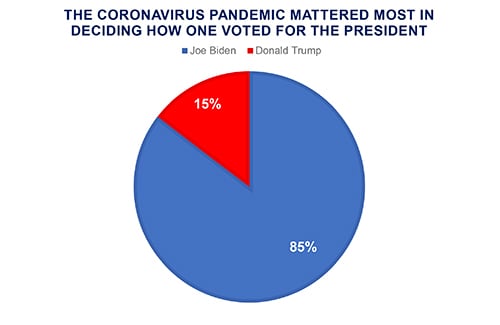
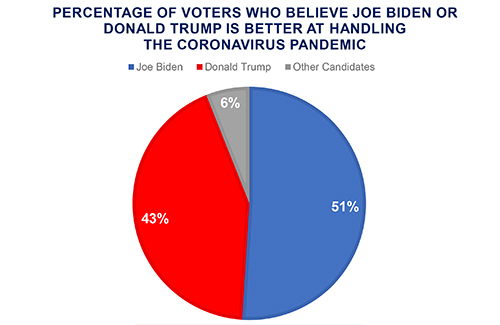
Second, the Supreme Court nomination fight was initially thought to be a net positive for President Trump and congressional Republicans, but polling data shows it motivated Democratic voters to turn out in numbers that blunted a historic Republican advantage.
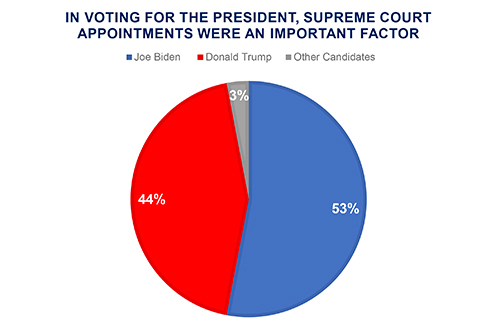
Third, Joe Biden edged out President Trump with voters who rated the economy as their top issue in the race.
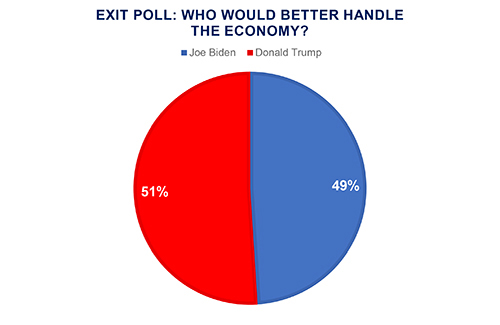
Fourth, women were a particular strength for the Biden-Harris ticket, driven in part by the potential election of the first female vice president, but another notable trend was the swing of suburban, highly educated women who favored President-elect Biden over President Trump.
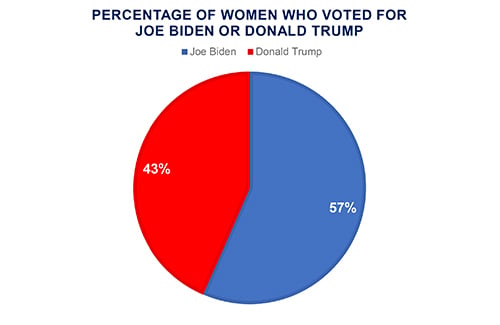
Fifth, President-elect Biden undercut President Trump's 2016 strong level of support with senior citizens, as Biden ended up with 48% of the senior vote in 2020. President-elect Biden won every other age demographic under 65 years of age.
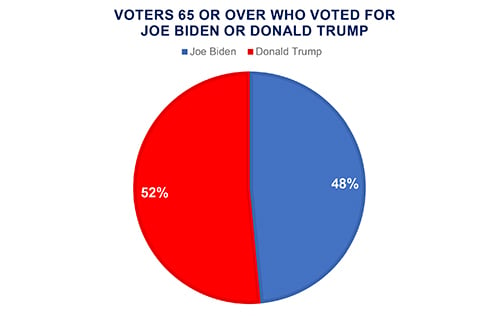
Sixth, President Trump picked up more African-American and Hispanic support in 2020 than he had in 2016, but the Biden-Harris ticket retained a high-enough percentage of African American and Hispanic voters to win out in critical states like Arizona, Georgia, Michigan, and Wisconsin.
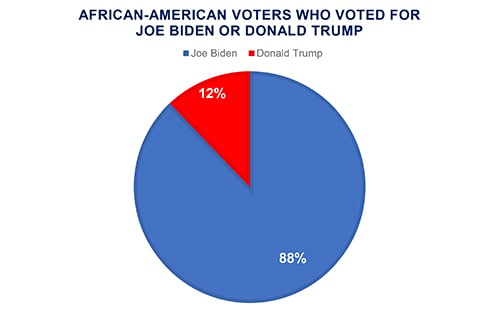
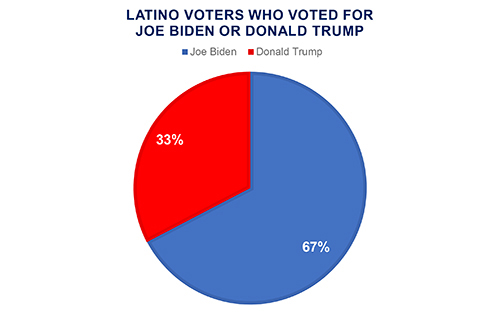
Finally, the suburbs represented the winning margin for the Biden-Harris ticket in almost every swing state, as affluent, highly educated (college degree or higher) voters were runaway supporters of the Biden-Harris ticket this year.
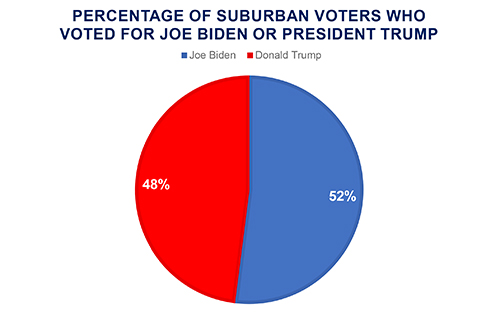
© Arnold & Porter Kaye Scholer LLP 2021 All Rights Reserved. This Advisory is intended to be a general summary of the law and does not constitute legal advice. You should consult with counsel to determine applicable legal requirements in a specific fact situation.
-
What is historic and unique about the 2020 election results?
Control of Washington continues to shift in most federal elections
- This is the ninth time in the last eleven federal elections (since 2000) that control of at least one chamber of Congress or the White House has changed hands.
- Control of the White House changed parties four times in the six presidential elections since 2000 (2000, 2008, 2016, 2020).
- The Senate has changed hands five times (2000, 2002, 2006, 2014, 2020) in the eleven federal elections since 2000.
- The House has changed hands three times (2006, 2010, 2018) in the eleven federal elections since 2000.
White House
- President-elect Biden is the first man elected to the White House without winning Florida or Ohio since John F. Kennedy in 1960. The winner of Florida and Ohio had gone on to win the White House in the last six elections before 2020.
- President-elect Biden is the first person elected to the White House after serving 13 or more years in the US Senate.
- President-elect Biden is the first Democratic vice president directly elected president since Martin Van Buren in 1836.
- President-elect Biden is the first Democrat elected president without winning either the Iowa caucuses or the New Hampshire primary since President Bill Clinton in 1992.
- President-elect Biden and President Nixon are the only vice presidents elected president after an intervening administration of the opposite political party.
- President-elect Biden joins Presidents Nixon and Reagan as the only three elected presidents in the modern (primary/caucus) era who failed to secure the nomination of their party in their first run.
- President Trump is the first president in 28 years not to be reelected.
© Arnold & Porter Kaye Scholer LLP 2021 All Rights Reserved. This Advisory is intended to be a general summary of the law and does not constitute legal advice. You should consult with counsel to determine applicable legal requirements in a specific fact situation.
-
How will the fight for the Senate in the 2022 elections affect the legislative process?
Democrats took away control of the Senate from Republicans in the 2020 election and will start with favorable political circumstances to retain control in the 2022 elections.
The election of Kamala Harris as Vice President left California Governor Gavin Newsom to fill her vacant Senate seat. In December, he nominated California Secretary of State Alex Padilla to serve the remaining two years of Vice President-elect Harris's term. Padilla will be the state's first Hispanic Senator and he will have to run an expensive jungle primary and general election in 2022, in a state where fellow elected Democrats present the heaviest competition. Two female senators have represented California for the last 28 years, so it is reasonable to project that one or more Democratic House members like Karen Bass (D-CA) or Katie Porter (D-CA) will run against Padilla in 2022.
Three of the current four longest-serving senators—Sens. Pat Leahy (D-VT), Chuck Grassley (R-IA), and Richard Shelby (R-AL)—may retire rather than run in 2022. This would make reelected Majority Leader McConnell the longest-tenured member of the Senate in 2023.
Several broader factors favor Democrats in 2022 Senate races:
- Republicans will have 20 seats at risk while there are only 12 Democratic seats up for reelection. Generally speaking, the party playing offense in recent election cycles has done better than the party playing defense. The fact Republicans are playing defense in 2022 will seep into every strategic decision they make in the Senate over the next two years.
- Retirements are the best chance to pick up seats long held by the other party. An open seat in Alabama, where Sen. Shelby will be 88 on election day 2022, is probably a case where the winner of the Republican primary fight easily wins in the general election. The story is different in Iowa, where Sen. Grassley will be 89 on election day in 2022, and the other Senate seat has been very competitive, including Sen. Joni Ernst's (R-IA) close 2020 reelection win with just 52% of the vote. In Pennsylvania, Sen. Pat Toomey (R-PA) announced his retirement before the 2020 election, in a state where he won with only 48.8% in 2016, and where the last two presidential races have been very close. Finally, in North Carolina, Senator Richard Burr (R-NC) is retiring, opening a seat he won with just 51.1% six years ago. Sen. Thom Tillis (R-NC) won his 2020 bid for reelection with just 49% of the vote in the most expensive Senate race in American history, so North Carolina will be a key 2022 battleground.
- Senate elections now closely track which party won the most recent presidential race in the state. Seven Republicans won close races in 2016 as President Trump won narrow victories in their state, and, whether or not they run for reelection, Republicans face political headwinds in those states in 2022: Sens. Marco Rubio of Florida (won with 52% in 2016), Todd Young in Indiana (51.1%), Richard Burr in North Carolina (51.1%), Ron Johnson in Wisconsin (50.2%), Roy Blunt in Missouri (49.2%), Pat Toomey in Pennsylvania (48.8%), and Lisa Murkowski in Alaska (44%). Those candidates also will not have a presidential campaign to help them with organization and messaging in 2022.
Senate Democrats have risks of their own in 2022. Four incumbents come from battleground states that will be high-profile and expensive races in 2022: Sens. Michael Bennet in Colorado (won with 50% in 2016), Maggie Hassan in New Hampshire (48%), Catherine Cortez Masto (47.1%), and Ralph Warnock (50.6% in the January 5 runoff). Sen. Leahy, the current longest-serving senator in either party with 45 years of experience, may retire, but the seat is considered a safe Democratic one if he does.
© Arnold & Porter Kaye Scholer LLP 2021 All Rights Reserved. This Advisory is intended to be a general summary of the law and does not constitute legal advice. You should consult with counsel to determine applicable legal requirements in a specific fact situation.
-
Who are the GOP White House frontrunners for 2024?
On the Republican side, the Trump-Pence loss means the field is wide open for the 2024 presidential nomination. President Trump has indicated he may run again but his post-election actions were not consistent with positioning himself for another run at the White House. The President's actions since the election have created a visible fracture in the Republican party between those seeking to distance themselves from the controversies of the Trump Administration and those seeking to claim they are the logical successor to Trump's vision for the party and the country. That fracture was on display when House and Senate Republicans split over challenging the electoral college votes of select states when Congress convened on January 6 to certify the results of the presidential election.
Vice President Mike Pence has the resume of a leading candidate, given his experience as a member of House leadership, Governor of Indiana, and four years as vice president. No vice president has ever been elected president after his president lost his bid for reelection, so Vice President Pence will be fighting history if he pursues the nomination.
Republicans have a deep bench of Senators and Governors who will look hard at the 2024 race. In the Senate, Sens. Marco Rubio (R-FL), Ted Cruz (R-TX), and Rand Paul (R-KY) have run before and have a national profile that would benefit them if they were to try again. Sens. Tom Cotton (R-AR), Josh Hawley (R-MO), Ben Sasse (R-NE), and Tim Scott (R-SC) also may consider the race. Among governors, four spark serious interest among party faithful: Greg Abbott of Texas, Ron DeSantis of Florida, Larry Hogan of Maryland, and Kristi Noem of South Dakota. Finally, former South Carolina Governor and UN Ambassador Nikki Haley is eyeing the race.
© Arnold & Porter Kaye Scholer LLP 2021 All Rights Reserved. This Advisory is intended to be a general summary of the law and does not constitute legal advice. You should consult with counsel to determine applicable legal requirements in a specific fact situation.
-
What happens if President-elect Biden serves only one term?
There is speculation that Mr. Biden will only serve one term in office, since he will be the oldest American elected president. If that scenario comes to pass, Vice President-elect Harris becomes the immediate and overwhelming front-runner for the 2024 Democratic nomination, and she will have at least two years to consolidate her power and put together a team to pursue the 2024 nomination. The last four Democratic vice presidents all were later Democratic nominees for president (Humphrey in 1968, Mondale in 1984, Gore in 2000, and Biden in 2020), but each faced major primary battles. Nevertheless, each of those vice presidents faced major primary fights from senators and governors before they emerged with the party's nomination, and only Mr. Biden turned that nomination into a general election victory. It seems likely President-elect Biden selected Kamala Harris to be his vice president knowing already he would back her as his successor.
The Vice President-elect will not necessarily have a clear path to the Democratic nomination if President-elect Biden only serves on term. Major challengers will likely come from a sitting governor or senator. Sens. Bernie Sanders (I-VT) and Elizabeth Warren (D-MA) ran for the 2020 nomination but are likely too old to do so again in 2024. Sens. Kirsten Gillibrand (D-NY) and Amy Klobuchar (D-MN) are possible second-time presidential candidates, but each would need a compelling and contrasting profile to challenge the sitting female vice president of their own party. In the ranks of sitting governors, there are several candidates who may see 2024 as their one best shot for the White House, including Andrew Cuomo of New York, Michelle Lujan Grisham of New Mexico, Jared Polis of Colorado, Gina Raimondo of Rhode Island, Gretchen Whitmer of Michigan, and Tom Wolf of Pennsylvania. Many of those governors first face 2022 reelections. Given the Democratic Party's continued evolution to the left, it is possible a progressive outsider could also be a serious presidential contender in the next election cycle.
© Arnold & Porter Kaye Scholer LLP 2021 All Rights Reserved. This Advisory is intended to be a general summary of the law and does not constitute legal advice. You should consult with counsel to determine applicable legal requirements in a specific fact situation.














